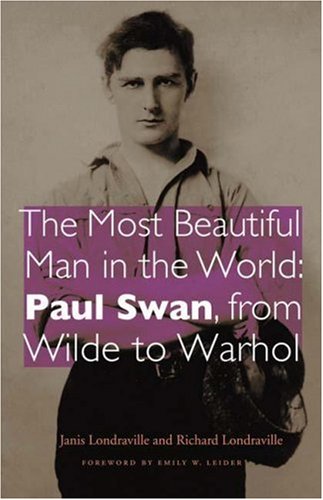
BY TRAV S.D. | In honor of Pride Month, we will be featuring one article per week on a different classic performer, one for each category: L, G, B, T, and Q! With only five weeks in June, that’s our limit. Check back with us next year, as our series picks up with “+” I, A, and beyond. . .
Following up on previous posts (“L” Alla Nazimova and “G” George Kelly,) today an introduction to our bi guy, Paul Swan (1883-1972). It can safely be said that Swan was one of the most remarkable people of the 20th century, having been a painter, sculptor, model, dancer, choreographer, poet, movie actor, set and costume designer, and, for a few weeks in 1914—vaudevillian. Furthermore he functioned in all these areas at the very highest levels, enjoying national and even international reputations in some of these fields.
Born on an Illinois farm, Swan was eccentric from childhood, alienating himself from his family and all of his neighbors by covering his hands and face with burlap sacks as he plowed so that he wouldn’t get a tell-tale farmer’s sunburn. Inheriting artistic talent from his mother and paternal grandfather, he drew pictures every chance he got. When he became a teenager, he made several ill-fated attempts to move to several Midwestern cities, taking some art classes, and working at a succession of jobs (window dresser in a department store was one of them).
Finally in 1906, he was able to move to New York, where he got a job at Dilineator magazine drawing ladies hats. In1908, one of his illustrations made the cover of Putnams magazine, and from then on, things started to slowly change for him. The turning point in his life came when he painted a life-sized portrait of the actress Alla Nazimova at his own expense on spec, and sent it to her, resulting in a commission for several more, and the chance to live with her for several months. From that moment on, he was a man of the world. A tour of the great capitols of the Renaissance and antiquity fed his art immeasurably, and inspired what he was probably best known for in his lifetime, a series of self-created dances based on classical Greek and Egyptian poses, in costumes he designed himself. Although untrained as a dancer, at this stage he sought out Isadora Duncan and others to study with. He painted Duncan’s portrait, and was possibly her lover. Circa 1911, he married Helen Palmer Gavit, granddaughter o sculptor Erastus Dow Palmer, though he continued to have lovers, both male and female, throughout his life.
After Swan returned to the states, he toured the country with his unique dances, to great acclaim. And this is how he happened to be booked by to play Hammerstein’s Victoria, for several weeks in 1914 billed as “The Most Beautiful Man in the World.” Audiences were confused by him at first, and were apt to laugh at his performances (this type of reaction was to dog him from some quarters all his life). But critics praised him, and, once he began lecturing audiences from before the footlights, they came around, too. Meanwhile, his own visual art was winning prizes and commissions all over the world, and he himself, with his Dorian Gray-like visage, became the muse of many an artist, as well. In addition to the many portraits he sat for, he was to appear in a number of Hollywood movies, including Diana the Huntress (1916), The Ten Commandments (1923) and Ben Hur (1925).
Swan continued to be celebrated for his visual art into his old age; as late as 1960 he was featured in Life magazine. Unfortunately though, he seemed to be in denial about the fact that he had aged, and became something like a local figure of fun, a New York character. With badly dyed hair and a great deal of make-up, he continued to perform his Greek dances (in full toga and sandal costumes) weekly for small audiences well into his 80s. It was at this stage of his life that Andy Warhol made several films of him: Paul Swan, Camp and Paul Swan I-IV, all made in 1965. Thus, even into his old age he continued to be both an artist and an art object, although the context had shifted incredibly. The idea that he was something of a joke may have hurt his reputation as a serious artist, although he does have his critical admirers today and his paintings and sculptures are in museums all over the world.
Note: Book jacket pix of “The Most Beautiful Man in the World: Paul Swan, from Wilde to Warhol” by Janis Londraville and Richard Londraville via Amazon.com. To order, click here.
Chelsea Community News is made possible with the help of our awesome advertisers, and the support of our readers. If you like what you see, please consider taking part in our GoFundMe campaign (click here). To make a direct donation, give feedback, or send a Letter to the Editor, email scott@chelseacommunitynews.com.

Pingback: Countdown for Pride – (Travalanche)